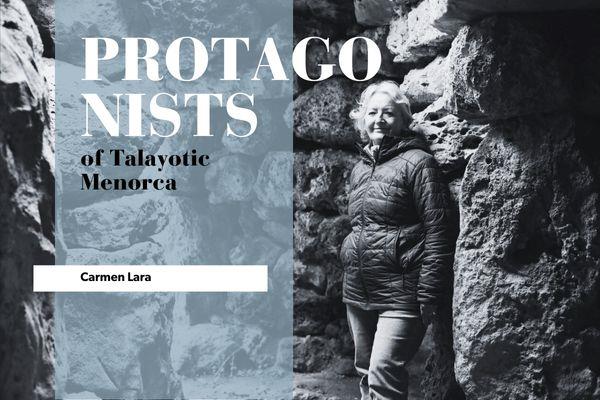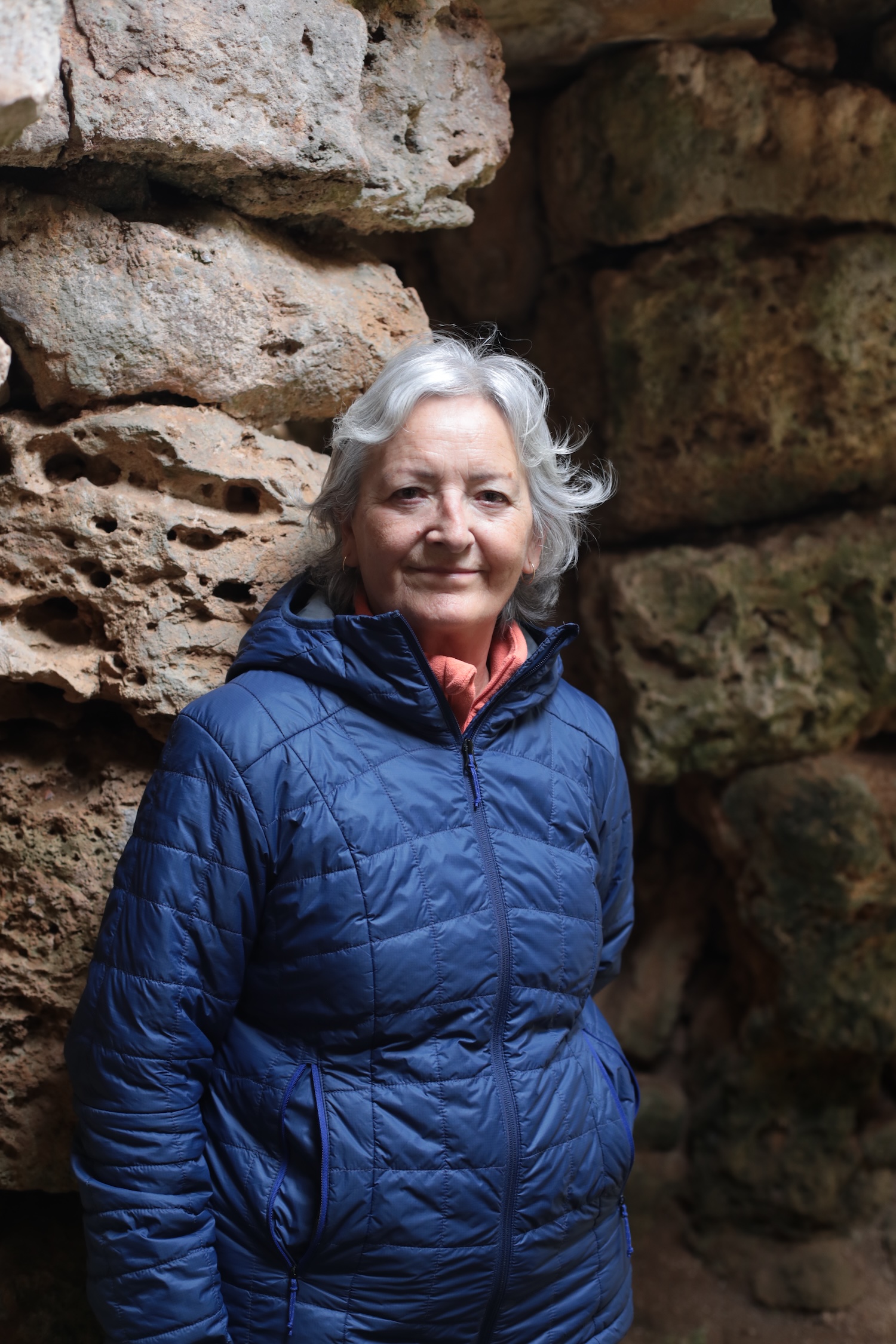 Carmen Lara Astiz, born in Estella-Lizarra (Navarre), is an archaeologist with extensive experience linked to Talayotic Menorca. She studied Geography and History and specialised in Prehistoric Archaeology at the Autonomous University of Barcelona. Her experience has led her to participate in excavations in various places such as Menorca, Navarre, Catalonia, France and Cyprus.
Carmen Lara Astiz, born in Estella-Lizarra (Navarre), is an archaeologist with extensive experience linked to Talayotic Menorca. She studied Geography and History and specialised in Prehistoric Archaeology at the Autonomous University of Barcelona. Her experience has led her to participate in excavations in various places such as Menorca, Navarre, Catalonia, France and Cyprus.
Now retired, she worked in the Department of Prehistory at the Autonomous University of Barcelona (UAB) for twelve years, and from 2003 to 2009 as head of the archaeological brigades of the Heritage Service of the Consell Insular de Menorca. Between 2009 and 2010, she was archivist at the Historical Archive of Maó, and worked at the Fundació Foment del Turisme de Menorca from 2010 to 2022 as head of cultural tourism. She has published several research articles and has given several conferences throughout Spain and France. She is a member of IME (Institut Menorquí d'Estudis) and GRAMPO (Grupo de Investigación Arqueológica del Mediterráneo y Oriente Próximo) of the UAB.
She arrived on our island to collaborate in the excavations at Talatí de Dalt with colleagues from the Museu de Menorca. Since then, she has participated in projects such as Biniai Nou, Son Olivaret, Fort Marlborough, Torre d'en Galmés -a project she co-directed for fifteen years-, or the documentation of the Cova des Càrritx, among other archaeological interventions. She has also directed a large number of archaeological controls at various sites on the island, in actions promoted by the Consell Insular de Menorca.
Why did you choose archaeology? How did your interest in this discipline begin?
Ever since I was a child I had been attracted by everything I could read about excavations all over the world, and I was also very interested in Geology. I started by excavating medieval remains in my village, but when I went to the first prehistoric excavation, the Palaeolithic, in Berga, I knew I wanted to dedicate myself to this.
What interested you about the Talayotic archaeology of Menorca?
The first time I came to Menorca was to excavate, but I always had the memory of the Naveta des Tudons on the cover of my third-year Baccalaureate book, so my curiosity was first towards the navetas; however, in the end I was interested in everything. Everything was different from what I had excavated until then and very interesting because it was unique.
You have participated in archaeological interventions in Talatí de Dalt and Biniai Nou, and in the documentation of the Cova des Càrritx. Which is the project that has had the greatest impact on you as a researcher?
The Cova des Càrritx was very different because of the archaeological remains that were documented with such an unknown burial ritual. In any case, I didn't excavate, but what I did was the planimetry, specifically the sections of the interior and the floor plan and sections of the exterior of the cave. I also drew all the bone and metal material that was documented in the cave, so I enjoyed and learned a lot.
Your field of study is the combustion structures of the Talayotic period: fires, hearths, ovens. What information can they give us about our ancestors?
It is a subject that I am very passionate about, as well as other types of domestic material built on land. As for the combustion structures, the information they give us is related to the customs, types of habitat and the way of eating of the people who inhabited the domestic spaces, or they are also related to their economy. For example, in Torre d'en Galmés, inside the houses (known as circles), we have documented fireplaces where food was cooked, where we documented ceramic hearths, very common in peninsular prehistory.
We also identified the remains of carbonised cereal seeds. Ovens have also been documented, which would have been used to make pottery, or combustion points with the remains of metal slag, evidence of metallurgical work. A very interesting discovery was made inside a circular house: a brazier built in the earth, with a rubefacted hearth, where the coals must have been placed to be transferred from the bonfire, located in the courtyard of the house, to the rest room to heat and illuminate it. All this information, together with other material remains that have been documented and the architecture of the houses themselves, gives functionality to the different spaces that make up the house, and informs us about the way of life of these people who lived in the prehistoric times of the island.
 Which of the projects that are currently underway arouse your interest the most?
Which of the projects that are currently underway arouse your interest the most?
In my opinion, they are all very interesting because they all contribute a great deal to our knowledge of Menorca's prehistory, but without a doubt, what I am most interested in is the excavation of the taulas. A team of archaeologists has been excavating one of these buildings for years now and they can provide a lot of information that we are still missing. So we will be looking forward to what they have to say about their research.
You participated intensely in the different stages of preparation of Menorca's Talayotic candidacy for World Heritage status. How have you experienced the whole process?
Well, with great enthusiasm. I was on the technical committee from the first dossier until now that we are a World Heritage Site. It has been a very long but intense journey. We have always worked without letting our guard down, with the participation of many people doing the various studies for the dossier, with a lot of enthusiasm, and it has been worth it because the reward has been really great. Menorca deserves it because it has a unique archaeological heritage with exceptional conservation.
What challenges do you see for Talayotic Menorca now that we are a World Heritage Site?
Now is when the important stage of management begins, through the Talayotic Menorca Agency. There are many challenges; we are a World Heritage Site and we must not lose our focus. Now is the time when we have to carefully enhance the value of what we have: the maintenance of the monuments and their conservation comes first. Good management in terms of visits, continuing with the pedagogy that is carried out with the programmed excursions aimed at the population of Menorca, at schools.... And also very important is research, which is what will fill the knowledge about the sites with content and which is the basis of Talayotic Menorca. Without research, being World Heritage would be meaningless, because it is the knowledge of the monuments that really gives them value and is what gives response to the remains that make up this landscape, which in turn is the day to day of what the Menorcans and the people who visit us see.
From your experience in historical heritage management, how do you think the relationship between Talayotic Menorca and tourism should be approached?
To spread the word but with a clear head, that is to say, to control what we are selling. We must always think about the pressure of tourism on the monuments and that is what must be controlled, the monitoring of the sites, which is the tool that forms part of the management plan. In this way we control the site and at any given moment we can activate the plan required by each situation, in order to correct it as quickly as possible and avoid undesired effects on the monuments. It is also important that the type of information we transmit to the tourist is pedagogical, that it teaches them to enjoy the site they are visiting with respect.